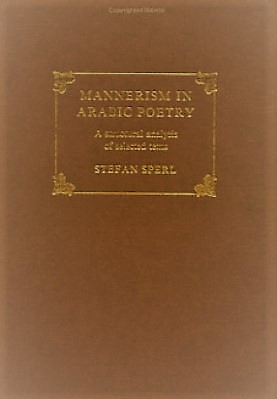Mannerism in Arabic Poetry: A Structural Analysis of Selected Texts (3rd Century AH 9th Century AD – 5th Century AH 11th Century AD)

| Mannerism In Arabic Poetry |
| Stefan Sperl |
| 238 |
| |
| PDF Direct Download Link |
| Click for Hard Copy from Amazon |
MANNERISM IN ARABIC POETRY – Book Sample
About the Book – MANNERISM IN ARABIC POETRY
Sperl’s-study questions whether mannerism and classicism can be applied to the analysis of Arabic poetry. While mannerism in Arabic literature has traditionally been associated with an excessive use of rhetorical devices and illustrated with reference to poetic fragments and extracts, Sperl approaches the question through a structuralist examination of poems as a whole.
The texts selected range from the 9th to the 11th centuries AD and are drawn from the works of Abu l-Atahiya, Buhturi, Mihyar al-Daylami and Maarri.
The poems which are studied in detail in successive chapters exhibit profound stylistic differences in sound, imagery, and composition. In the light of structuralist analysis, these differences do indeed appear to conform to a characteristic classicist/mannerist continuum also observed in other literatures. The structuralist approach moreover leads to a broader reevaluation of these terms in the final chapter
Introduction
Stimulated by the debate on mannerism in literature which followed the appearance of E. R. Curtius’s celebrated work European Literature and Latin M iddle Ages (1953), this book attempts to identify elements of mannerism and classicism in medieval Arabic poetry.
Mannerism in Arabic has usually been linked with the appearance of an ornate rhetorical style caled badi’ which became characteristic of poetry and prose from the fifth century AH/ninth century AD onwards.1 This study, however, is not so much concerned with the discussion of rhetorical devices as manifest in selected passages and individual lines of poetry; rather, it seeks to attain its objective through a structuralist analysis of whole poems.
This makes it necessary to address the much-debated issue of the unity of the individual poem in Arabic.
The inquiry, therefore, begins with the formulation ofa hypothesis on the structural coherence of a cardinal form of poetic expression – the poly thematic, panegyric ode or qaşida (see Glossary). in chapters two and three this hypothesis serves asa basis for structuralist analyses of poems by Bui)turı (d. about 284 AH/897 AD) and Mihyar al-Daylamı (d. 428 AH/1036 AD).
Chapters four and five turn to ascetic poetry. Selected works from the Zuhdiyyiit of Abü l-‘Atahiya (d. 213 AH/828 AD) and the Luzümiyyiit of Ma’arri(d. 449 AH/1058 AD) are examined in the light ofthe same hypothesis. The texts of ali works analysed appear with translations and brief commen taries as an appendix to this book. After reviewing the debate on mannerism in Arabic literature, the final chapter proceeds to describe mannerism and classicism as contrasting styles in which the individual poem relates in fundamentally different ways to the literary convention from which it arises and the subject matter it portrays. T
`he texts analysed in chapters two to five are then discussed as manifestations ofthese styles in medieval Arabic poetry. While this study is thus concerned with the stylistic range of a poetic tradition, it does not attempt to provide an historical analysis of stylistic development. What is intended is best clarified by reference to the views S. ı;>ayf and W. Heinrichs have expressed on the development of style in Arabic poetry. in his work al-Fann wa-Madhiihibuhu fi al-Shi’r al-‘Arabı, S. ı;>ayf
To read more about the Mannerism In Arabic Poetry book Click the download button below to get it for free
Report broken link
Support this Website
for websites